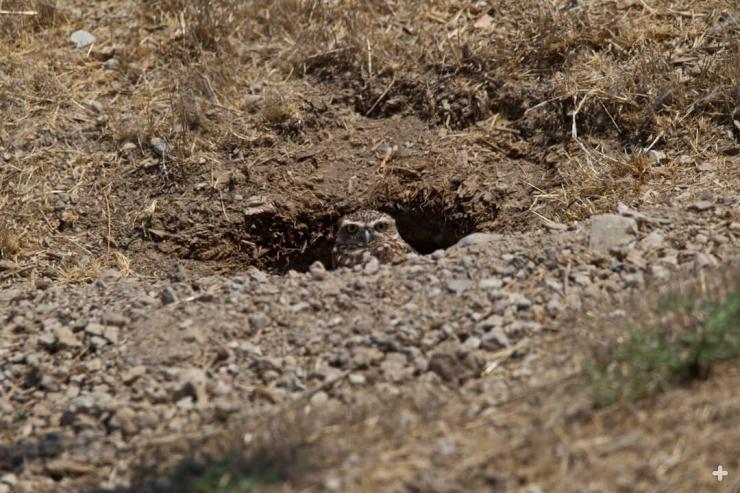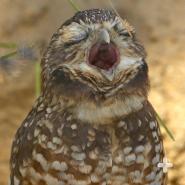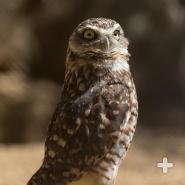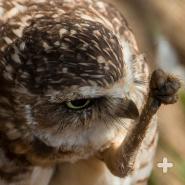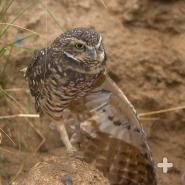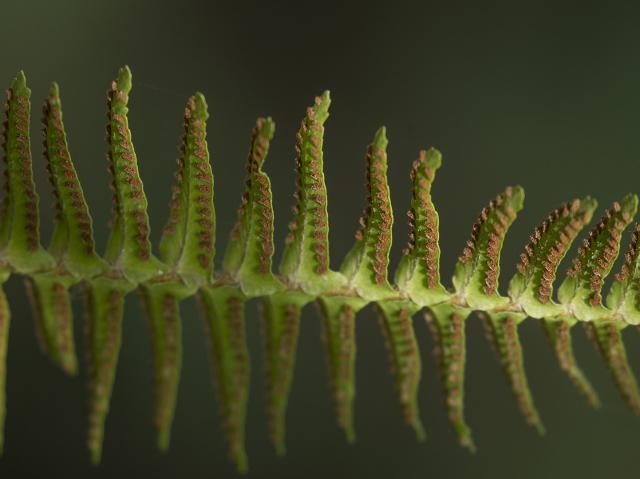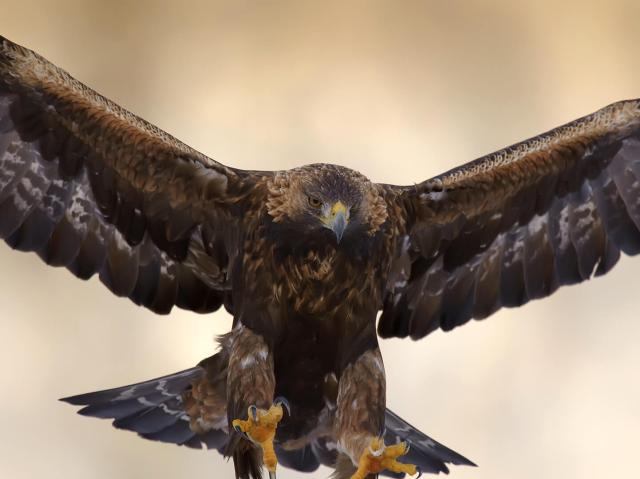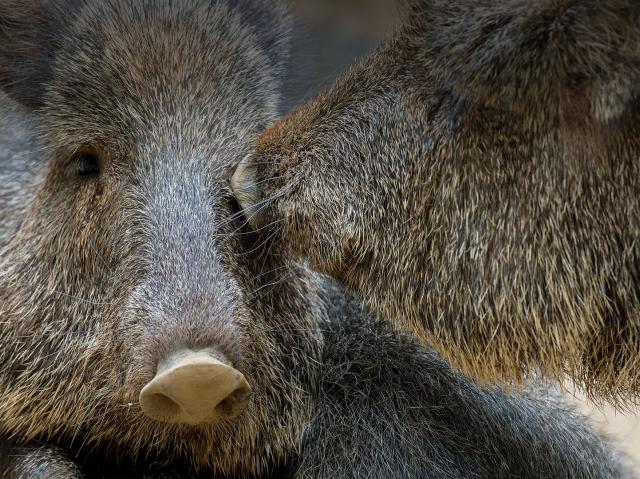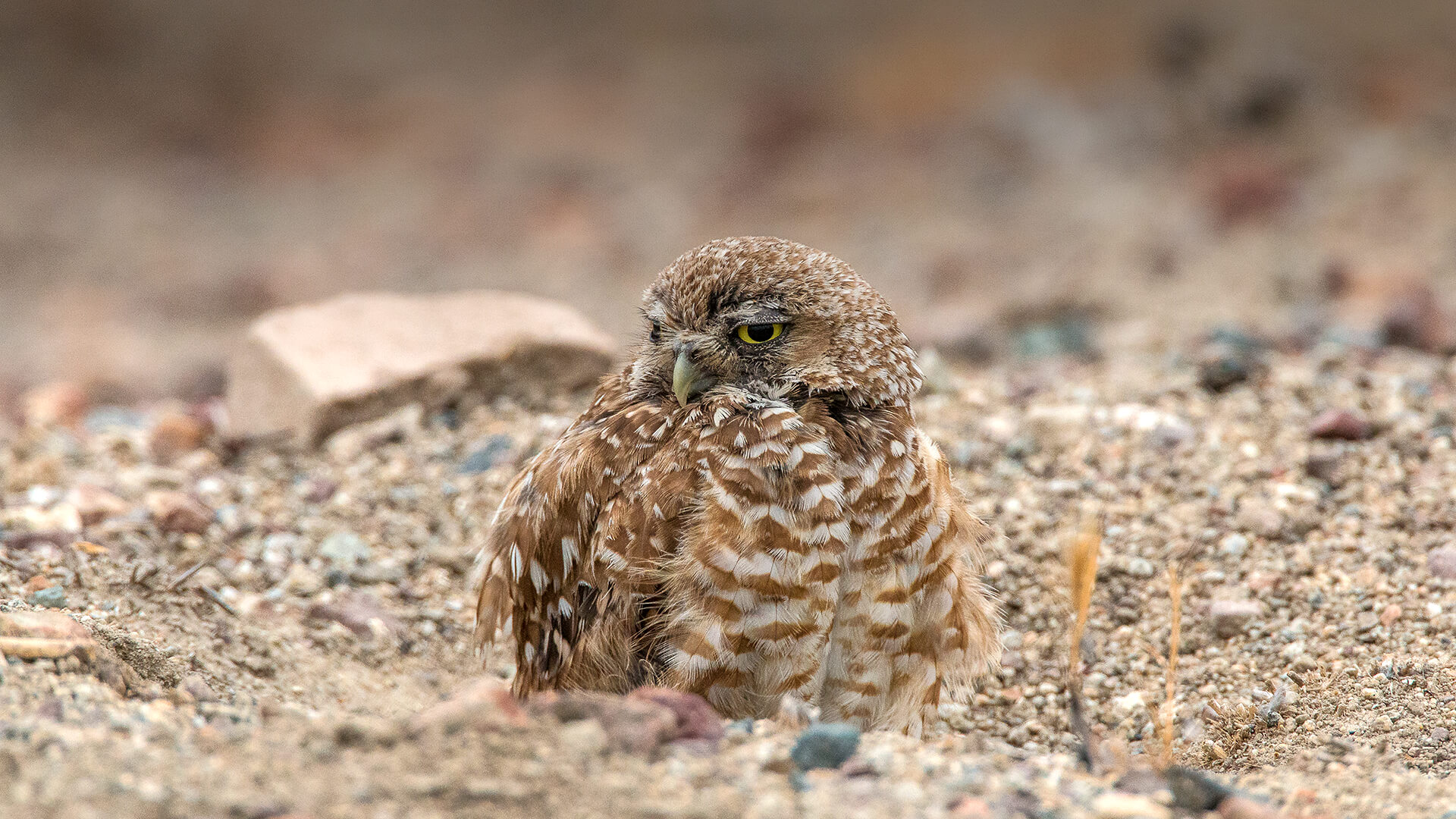
Burrowing Owl

- Class: Aves
- Order: Strigifromes
- Family: Strigidea
- Genus: Athene
- Species: cunicularia

ABOUT
Named for the Greek goddess of knowledge and wisdom, Athena, whose trusty companion was an owl, the burrowing owl shows off its smarts by using some brilliant tactics to provide for and protect its offspring. Instead of wasting precious energy and time digging their own burrows for nests, the burrowing owls will often use existing burrows from squirrels, rodents, or even reptiles.
Pretty bird. The burrowing owl has striking eyebrows, big bright eyes, and long legs. They are about the size of a robin but with a bit more bulk, with a large round head and short tail. Their coloring ranges from dark to sandy brown, with light brown to white spots, and they have a lighter belly. Unlike other owls, the male and female are roughly the same size.
Take cover. Horned owls, hawks, foxes, badgers, and even domestic pests hunt the burrowing owl. The owls will often run into their burrows when they feel threatened—and to scare off predators, they will often make a hissing or rattling noise. This sound is very similar to the noises made by rattlesnakes, whose burrows the owls will often use.
HABITAT AND DIET
Home and the range. Burrowing owls can be found in a wide variety of areas, including open grasslands, deserts, coastal areas, and even suburban and urban areas. They have an extensive range, from southern Canada to the southern tip of Argentina.
Burrow in. Unlike other owls, burrowing owls use underground burrows for nesting. More often than not, they repurpose a burrow excavated by other wildlife, like ground squirrels, prairie dogs, armadillos, kangaroo rats, snakes, and tortoises. If the ground is soft or sandy, particularly in Florida, they dig the tunnels themselves.
Good eats. Burrowing owls eat insects and rodents, but they also hunt lizards, frogs, bats, songbirds, young rabbits, and even ground squirrels. Females tend to hunt during the day and often hunt insects. Males tend to hunt during night, hunting for rodents and other vertebrates. When the female is incubating the eggs, the male will bring food in the morning and evening. In addition, when the chicks have hatched both parents will forage for the nestlings.
Scat scatter. To help food come to them, the owls scatter animal scat at the burrow entrance to attract insects and beetles. If they end up with too much "home delivery," they may store extra food in a larder, similar to a pantry, in their tunnels. In 1997, one burrowing owl cache in Canada was found to contain more than 200 rodents.
FAMILY LIFE
Chicks and interior decorating. Burrowing owls are mostly monogamous and live in semi-colonial neighborhoods with burrows as close as 30 feet (9 meters) apart. The breeding season is from March to August, and breeding pairs often use the same burrows for many years.
To attract a mate, the male will make circular flights to show off, and sing a special song. He will also bring little gifts to the females, like food or something that catches his eye. Both male and female will preen each other on the face and head, and touch bills. During this time, the mated pairs will stay near their dedicated burrows. Non-breeding owls may live on tufts of plants and not in burrows.
The clutch size is 4 to 11 smooth, white eggs. After the eggs have been laid, the male continues to bring items to the female to decorate the nest, especially during the incubation period. At about two weeks old, the hatchlings start to explore the world out of the burrow, although they cannot fly yet. At about four weeks old, they start to take short flights around the burrow. By six weeks, the chicks will fledge, but stay in their parents’ territory to forage. They will become fully mature at one year old.
Owl chatter. Burrowing owls make a variety of noises to communicate, including clucking or a chattering call, and even hissing and rattling when alarmed. To show excitement or distress, they head bob.
AT THE ZOO
Owls in our care. The burrowing owls at the San Diego Zoo and San Diego Zoo Safari Park are part of a conservation breeding and reintroduction program, in conjunction with the U.S. Fish and Wildlife Service.
You can watch a live video feed of a pair of burrowing owls on our new online Burrowing Owl Cams. Check out our Aviary Cam and Burrow Cam, and watch as they establish and manage their burrow.
CONSERVATION
Under siege. Burrowing owls face threats from habitat loss, environmental toxins, and vehicle collisions. Additionally, western burrowing owls in San Diego County reuse the burrows dug by other wildlife, primarily ground squirrels, so they are at risk because of the decline of available burrows caused by certain programs that remove these rodents.
San Diego Zoo Wildlife Alliance has partnered with the U.S. Department of Fish and Wildlife to better understand habitat use, nesting success, and survival rates of birds in fragmented areas in San Diego County. GPS and satellite technology is helping to reveal the secret lives of burrowing owls.
Since 2011, San Diego Zoo Wildlife Alliance has been partnering with other organizations on several projects with burrowing owls found in San Diego County. One program involves tracking the population of the owls centered in Otay Mesa (near the US/Mexico border). To track the birds, many different techniques are used, like remote cameras, GPS mini backpacks with data loggers, and colored leg bands. San Diego Zoo Wildlife Alliance launched a citizen science project in 2019, where people with internet access can help classify field photos taken at burrow entrances. Check out Wildwatch Burrowing Owl at wildwatchburrowingowl.org.
Another conservation project is working to create a variety of ways to reestablish ground squirrels in certain protected areas in the county. Several tests have been conducted, including bringing ground squirrels into areas where they are no longer found and altering the landscape to encourage other squirrels to move in and dig burrows that the owls can reuse.
By supporting San Diego Zoo Wildlife Alliance, you are our ally in saving and protecting wildlife around the globe.
Life Span
8 to 10 years
Young
Incubation: 28 to 30 days
Number of eggs: 2 to 11 per clutch
Size
Height: 7.5 to 10 inches (19 to 25 centimeters)
Weight: 4.5 to 8.5 ounces (140 to 240 grams)
Wingspan: 20 to 24 inches (50 to 61 centimeters)
Fun Facts
Since burrowing owls spend a lot of time underground, they are much better at tolerating higher levels of carbon dioxide than other birds.
A few years ago, owl fans were overjoyed to realize that on the first Sunday in February, burrowing owls were trending online with pictures and stories with the hashtag #superbowl. But owl enthusiasts soon realized that the hashtag was to celebrate the Super Bowl and not to show off this “superb owl.” What a difference a space makes!
Even royalty loves the burrowing owl. An avid environmentalist and photographer, Her Imperial Highness Princess Takamado of Japan, has written numerous articles and taken some spectacular pictures of birds, including the burrowing owl.


